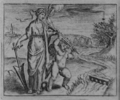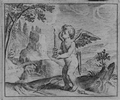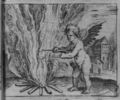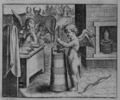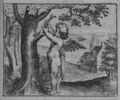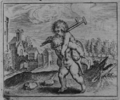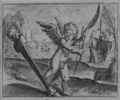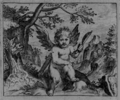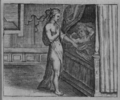Introduction
This is our edition of Duytse lier of 1671 by Jan Luyken. In this introduction, we have limited ourselves to the essentials.
About Jan Luyken
Jan Luyken was born in Amsterdam in 1649 to a Mennonite family. 1 In 1672, he married the actress-singer Maria de Oudens. She was admired and courted by many men; the young and talented poet Joan Antonides van der Goes was one of these men. Apparently, Luyken had Cupid on his side and he won the affection of his lady.
Luyken, an apprentice painter, ultimately became a poet and etcher. In 1671, his debut was published. It consisted of a collection of love poems called Duytse lier. He consistently created illustrations together with texts for the numerous books he published afterwards; each one more emblematic than the other, and always with a didactic or edifying bias aimed at guiding the readers in their social and ethical conduct. Often, his poems and pictures had a connection with everyday life. For instance, in the Spiegel van het menselyk bedryf (Mirror of the trades of men, 1694), 100 illustrations portray various crafts. His books were immensely popular in the Netherlands and abroad. Luyken's fame and interest in his books can be said to be affirmed by the existence of the many reprints and pirate editions.
Luyken was frequently assisted by his son Casper, who was also an etcher. Together, they produced approximately 3200 etchings and engravings. In principal, these etchings were designed to illustrate books of other Dutch writers. For instance, Luyken created the picturae of P. Huygen's Beginselen van Gods Koninkrijk (see elsewhere on this site).
Luyken could have lived a life of riches; yet, he chose to donate most of his earnings. Being a Mennonite, Luyken was respected in Amsterdam for this lifestyle, which was part of his strict religious attitude, and for spreading the Mennonite teachings through his devotional verses and illustrations. Jan Luyken died in his city of birth in 1712.
About the Duytse lier
The Duytse lier was printed by Jacobus Wagenaar, together with Adriaan Veenendaal. Both printers had their business in Amsterdam, only a few houses separated their two shops. While they were printing the nine 'Verdeelingen'(Parts) Luyken had given them as the original content of the Duytse lier, they asked Luyken for more material. Luyken then turned in the poems that would form the 'Tiende Verdeeling' (Part Ten) of the Duytse lier. This printing history of Luyken's very first emblem book could be the reason why only the first nine parts have a picturae taken from Otto Vaenius's Amorum emblemata (see: ) as their backbone. These picturae are preceded by a motto, and followed by a number of texts. It is dubious which one of these should be considered to be the subscriptio to the picturae in the traditional sense of the word. One could argue that only the first poem to follow the pictura can be called a subscriptio. The songs and poems following this poems should probably be labelled otherwise.
The nine picturae taken from Vaenius's Amorum emblemata (see: )did not stem from the 1608-edition of this book, but from its 1618-reprint by Blaeu, titled Emblemata aliquot selectiora amatoria (see: ). The engravings for this 1618-edition were made by Michel le Blon. Comparison of the picturae in the Duytse lier and emblemata aliquot selectiora amatoria has made clear that Luykens publisher re-used the same copperplates. This could also have been the reason why part ten of the book has no pictura. Did just nine copperplates survive, and was Luyken restricted by this circumstances when he composed the Duytse lier? Or were the nine picturae carefully chosen from a larger collection of copperplates that survived all these years?
The title-page of the Duytse lier give a good impression of its content. A satyr, a voluptuous creature, is holding a lyre, being accompanied by young women. This scene is placed against a pastoral background, which makes the erotic nature of the Duytse lier visible for every reader. This scene, and especially the star with lyre, also indicates that the Duytse lier should be looked upon as a songbook - even more so than as an emblem book. The poems in the first nine 'Verdeelingen' carry tunes to which they can be sung. According to its preface, these songs were meant for the 'vrolike Amstel-Nimphjes' - (joyful young women from Amsterdam (which is situated at the river the Amstel)).
Ever since the dissertation by Meeuwesse (1952, reprinted in 1977) the Duytse lier was seen as the book that showed signs of the conversion Luyken would undergo during his lifetime. Due to the fact that the last part of the book consists of poems in which Luyken voices his religious ideas (see for instance lu1671009_body1_div4lu1671009body1div4), the assumption was that these poems were written at a later dated, and were written while Luyken parted from his youthful playing of his earlier work to carry on writing religious lyrics. However, Gelderblom has made very clear that these poems should be seen in light of the Duytse lier as a whole. The book is dedicated to every aspect of love leading to marriage. Looking at it from this point of view, Luyken naturally mentioned more serious aspects of life while working towards the end of his series of emblems. Contemplations on the nature of human life quite logically found a place at the concluding statements in the Duytse lier. This became all the more clear when Luyken's personal circumstances were considered by Gelderblom. Luyken would marry in the beginning of 1672, with Maria den Ouden who he adored and courtshipped in the year he wrote and published the Duytse lier.
The Duytse lier was printed seven times in the seventeenth and eighteenth century (twice in 1671, and also in 1708, 1730, 1732, 1783). Based on this evidence alone, it can be stated that it had a considerable impact in its time. The book is also important because it marks the beginning of a revival of the Dutch love emblem: Luyken being the first poet to explore new possibilities of the genre for a long time.
Copy Used for This Edition
In making this edition of Duytse lier
we have used the copy of the edition of 1671 conserved in the Library of the
Amsterdam University , shelf number 2006 G 32. This digital edition is based on
Luyken, Duytse lier .
.
Transcription
We transcribed the full text from the Amsterdam copy and encoded this text using TEI mark-up; this allowed for flexibility in presentation and non-destructive editorial enhancement of the text. The full Project Guidelines for transcription, editorial intervention and indexing of the text are available elsewhere on this site.
Literature
The full Emblem Project Utrecht bibliography may be accessed using the menu option at the left side of this (or any) window. A selection of literature relevant to Jesus en de ziel follows here.
- Meeuwesse, Een teruggevonden werkje van Petrus Serarius

- Vekeman, Tussen essentie en existentie

- Vekeman, Jezus en de ziel: de zinnebeelden I en IV

- Landwehr, Emblem and Fable Books
 , no. 473
, no. 473
- Veld, Beminde broeder die ik vand op 's werelts pelgrim wegen

- Gelderblom, Binnen en buiten.

- Gelderblom, Leerzaam huisraad

- Visser, De pelgrimage van Jan Luyken door de doopsgezinde boekenwereld

- Visser, Seventeenth-Century Dutch Menonite Prayer Books

![[H O M E : Emblem Project Utrecht]](/static/images/rd-small.gif)




